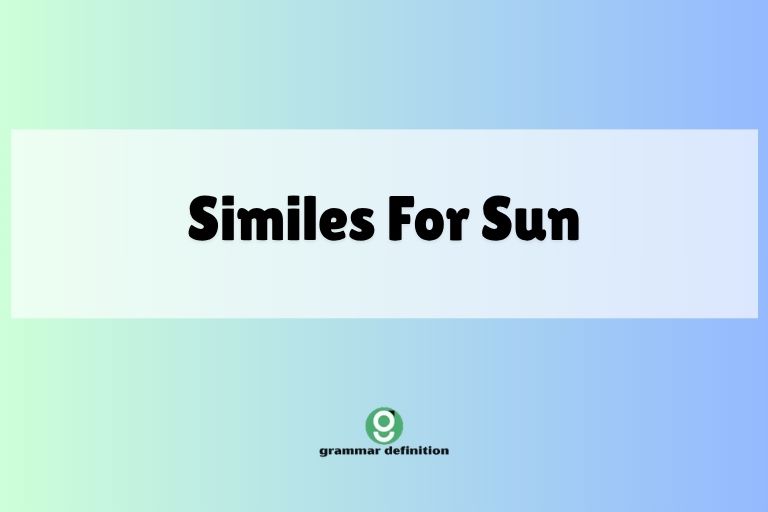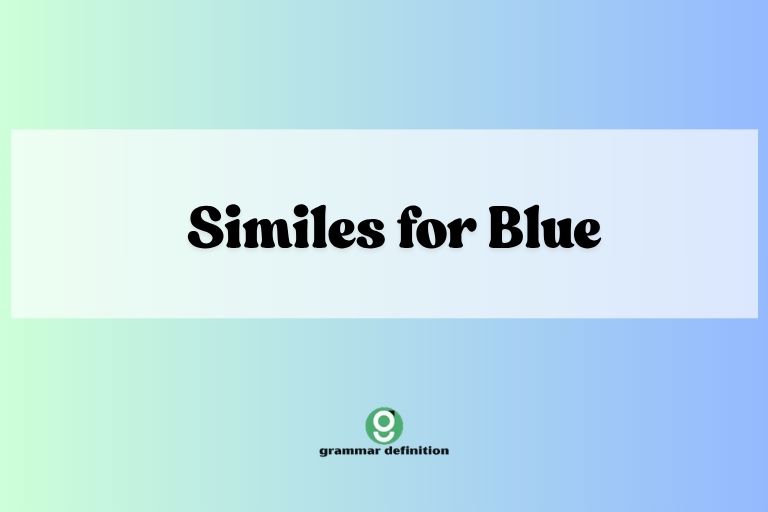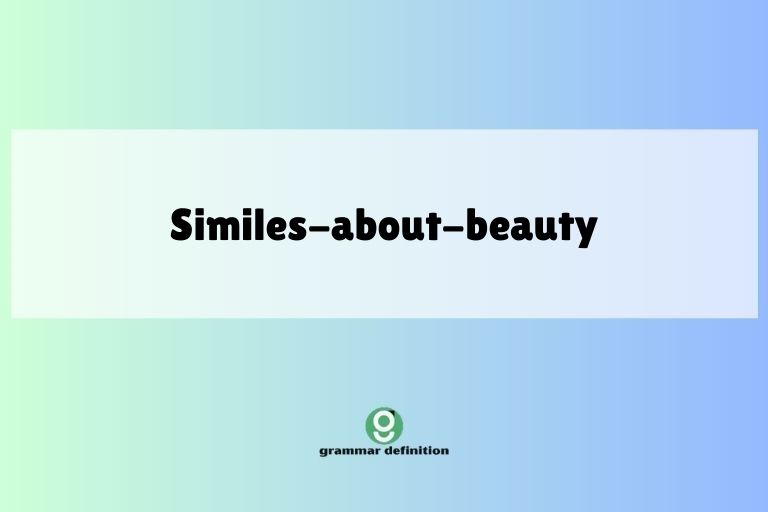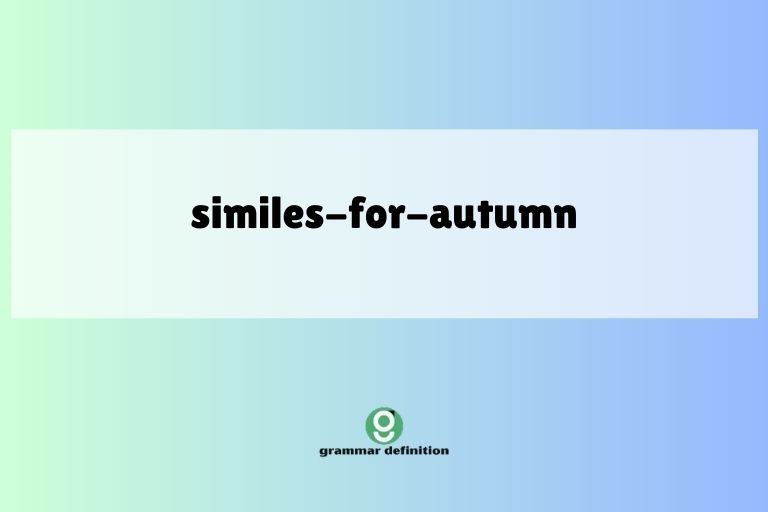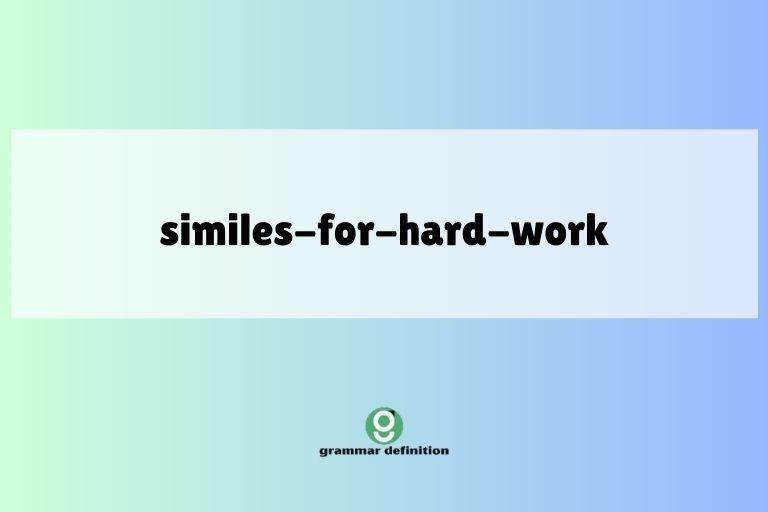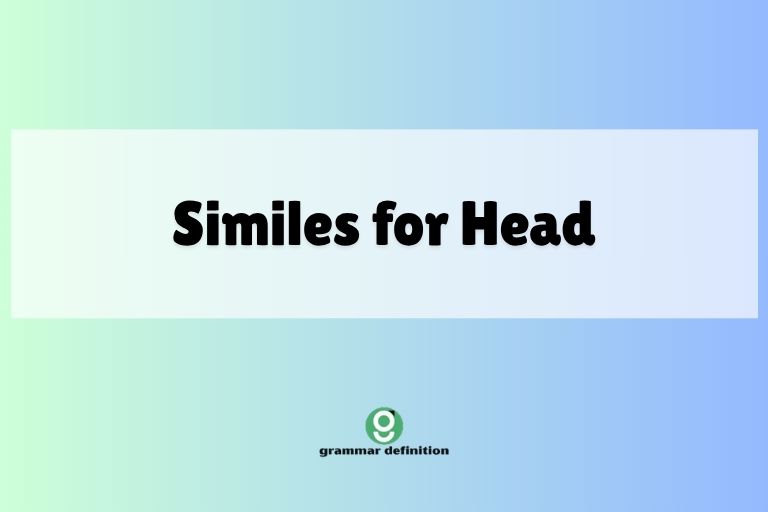Similes for Big: Mastering Figurative Language

Understanding similes is crucial for enhancing your descriptive writing and comprehension skills in English. Similes enrich language by drawing comparisons between seemingly different things, making descriptions more vivid and relatable.
This article provides a comprehensive guide to using similes to describe size, specifically focusing on the concept of “big.” Whether you’re a student, writer, or English language learner, this guide will equip you with the knowledge and practice to effectively use similes to convey the immensity and impact of “big” in your writing and speech.
From basic definitions to advanced applications, this article covers all aspects of using similes for “big,” including structural breakdowns, usage rules, common mistakes, and practical exercises. By the end of this guide, you’ll not only understand what similes are but also how to creatively employ them to add depth and imagery to your descriptions.
Table of Contents
- Definition of Similes
- Structural Breakdown of Similes
- Types of Similes
- Examples of Similes for Big
- Usage Rules for Similes
- Common Mistakes in Using Similes
- Practice Exercises
- Advanced Topics in Similes
- Frequently Asked Questions
- Conclusion
Definition of Similes
A simile is a figure of speech that compares two unlike things using the words “like” or “as.” Similes are used to make descriptions more vivid, engaging, and relatable by drawing parallels between the object being described and something familiar to the audience. The primary function of a simile is to create a mental image that helps the reader or listener better understand and visualize the subject.
In the context of describing “big,” similes help to convey the scale, size, or magnitude of something by comparing it to something else that is commonly understood to be large. For example, saying “as big as an elephant” immediately gives the audience a sense of the enormous size being described.
Similes can be found in various forms of literature, poetry, everyday conversation, and advertising. They are a powerful tool for writers and speakers to add depth and color to their language.
Structural Breakdown of Similes
The basic structure of a simile consists of three main components:
- The Subject: The thing being described.
- The Connector: The word “like” or “as.”
- The Analogy: The thing to which the subject is being compared.
The formula for a simile can be expressed as:
Subject + Connector + Analogy
For example:
The mountain (Subject) + was as (Connector) + big as a house (Analogy).
Understanding this structure allows for the easy creation and identification of similes. The analogy should be something that is widely recognized and understood, ensuring that the comparison is effective.
The strength of a simile lies in the clarity and relevance of its comparison.
Types of Similes
Similes can be categorized based on the type of comparison they make and the impact they have on the reader or listener.
Descriptive Similes
Descriptive similes focus on providing a detailed comparison that helps to visualize the subject. These similes often use sensory details to create a more vivid image.
Example: The building was as big as a skyscraper, towering over everything else.
Exaggerative Similes
Exaggerative similes, also known as hyperbole, are used to emphasize the size or scale of something by comparing it to something extremely large or exaggerated.
Example: The crowd was as big as the entire population of a small town.
Understated Similes
Understated similes use comparison to subtly convey the size or impact of something, often creating a sense of irony or humor.
Example: The responsibility felt as big as a paperclip, but it was actually crushing.
Figurative Similes
Figurative similes go beyond literal comparisons and use abstract or imaginative connections to describe size.
Example: His ego was as big as the universe, endlessly expanding.
Examples of Similes for Big
Here are several examples of similes that can be used to describe something as “big,” categorized for clarity and inspiration.
Table 1: Similes for Size and Volume
The following table provides similes related to physical size, volume, and scale. These examples are designed to help you describe the sheer magnitude of something.
| Simile | Explanation |
|---|---|
| As big as a house | Indicates a large size, often used for objects or buildings. |
| As big as an elephant | Emphasizes the large size and weight of something. |
| As big as a mountain | Suggests an imposing and massive size. |
| As big as a whale | Implies a very large volume or weight. |
| As big as a truck | Describes a substantial size, often used for vehicles or containers. |
| As big as a bus | Similar to “as big as a truck,” but often used for passenger vehicles. |
| As big as a football field | Used to describe a large area or space. |
| As big as a stadium | Indicates a very large enclosed space. |
| As big as an ocean liner | Suggests immense length and width. |
| As big as a castle | Implies grand scale and historical significance. |
| As big as a warehouse | Describes a large storage space. |
| As big as a factory | Suggests a large industrial structure. |
| As big as a skyscraper | Emphasizes height and modern construction. |
| As big as a country | Indicates a vast geographical area. |
| As big as the moon | Suggests a large celestial body. |
| As big as a planet | Implies enormous scale and astronomical significance. |
| As big as the universe | Represents the largest possible size. |
| As big as a giant | Refers to a mythical or exaggeratedly large being. |
| As big as a redwood tree | Implies significant height and age. |
| As big as a hot air balloon | Indicates a large volume and shape. |
| As big as a continent | Describes an extremely large landmass. |
| As big as a small car | Used to describe the size of some smaller objects. |
| As big as a grand piano | Used to describe the size of large musical instrument. |
Table 2: Similes for Abstract Concepts
The following table provides similes that describe abstract concepts such as problems, emotions, or ambitions as “big.” These examples help to convey the intensity and impact of these non-physical entities.
| Simile | Explanation |
|---|---|
| As big as a problem | A problem as big as a mountain. |
| As big as a worry | A worry as big as the ocean. |
| As big as an ambition | An ambition as big as the sky. |
| As big as a challenge | A challenge as big as the whole world. |
| As big as a dream | A dream as big as the universe. |
| As big as a responsibility | A responsibility as big as an entire company. |
| As big as a fear | A fear as big as the dark. |
| As big as a love | A love as big as forever. |
| As big as a hope | A hope as big as the stars. |
| As big as a mistake | A mistake as big as a war. |
| As big as a secret | A secret as big as the earth. |
| As big as a lie | A lie as big as the truth. |
| As big as a question | A question as big as everything. |
| As big as a change | A change as big as the future. |
| As big as an impact | An impact as big as history. |
| As big as a decision | A decision as big as life. |
| As big as an opportunity | An opportunity as big as fortune. |
| As big as a risk | A risk as big as everything you have. |
| As big as a sacrifice | A sacrifice as big as your heart. |
| As big as a burden | A burden as big as Atlas’ burden. |
| As big as a regret | A regret as big as a lifetime. |
| As big as a promise | A promise as big as hope itself. |
Table 3: Similes for Physical Attributes
The following table provides similes that describe physical attributes, such as muscles, height, or features, as “big.” These examples can be used to vividly portray someone’s physical presence.
| Simile | Explanation |
|---|---|
| As big as a bodybuilder | Describes someone with large muscles. |
| As big as a basketball player | Suggests great height. |
| As big as a sumo wrestler | Implies large size and weight. |
| As big as a giant | Refers to someone exceptionally tall and strong. |
| As big as a bear | Suggests a large and powerful build. |
| As big as a linebacker | Describes someone with a muscular build, typical of a football player. |
| As big as a heavyweight boxer | Indicates substantial size and strength. |
| As big as a Viking | Suggests a large and imposing physique. |
| As big as a mythological hero | Implies exceptional strength and size, often used figuratively. |
| As big as an oak tree | Describes someone sturdy and robust. |
| As big as a refrigerator | Suggests a bulky or square physique. |
| As big as a mountain gorilla | Implies immense strength and size. |
| As big as a Clydesdale horse | Describes someone with a powerful and muscular build. |
| As big as a Redwood | Describes someone imposing and powerful. |
| As big as a brick house | Describes someone who is physically well-built. |
| As big as a professional wrestler | Describes someone who is muscular and intimidating. |
| As big as a bouncer | Describes someone who is intimidating and powerful. |
| As big as a polar bear | Describes someone who is huge and powerful. |
Table 4: Similes for Volume (Sound)
These similes are used to describe the magnitude or intensity of sound.
| Simile | Explanation |
|---|---|
| As big as thunder | Describes a very loud, booming sound. |
| As big as a roar | Suggests a powerful and overwhelming sound. |
| As big as a concert | Implies a loud and immersive auditory experience. |
| As big as a jet engine | Describes an extremely loud and high-pitched sound. |
| As big as an explosion | Suggests a sudden and deafening sound. |
| As big as a symphony | Implies a rich and complex sound. |
| As big as a siren | suggests a loud and alarming sound. |
| As big as a stampede | Describes a chaotic and thunderous sound. |
| As big as a volcano | Suggests a tremendous and destructive sound. |
| As big as a waterfall | Implies a constant and overwhelming sound. |
| As big as a marching band | Describes a loud and rhythmic sound. |
| As big as a construction site | Suggests a noisy and chaotic sound. |
| As big as a rock concert | Describes a very loud and intense musical sound. |
| As big as a train | Describes a loud and rumbling sound. |
| As big as an earthquake | Suggests a powerful and earth-shaking sound. |
Usage Rules for Similes
When using similes, it’s important to follow certain rules to ensure clarity and effectiveness:
- Clarity: The comparison should be clear and easily understood by the audience. Avoid obscure or overly complex analogies.
- Relevance: The analogy should be relevant to the subject being described. The comparison should highlight a specific attribute or quality that is being emphasized.
- Originality: While common similes can be effective, try to create original comparisons to add a unique touch to your writing.
- Context: Ensure that the simile fits the context of your writing. The tone and style of the simile should match the overall tone and style of the piece.
- Avoid Clichés: Steer clear of overused similes that have lost their impact. For example, instead of saying “as big as a house” (cliché), try “as big as a mansion” or “as big as a small apartment complex.”
By following these rules, you can create similes that are not only descriptive but also engaging and memorable.
Common Mistakes in Using Similes
Here are some common mistakes to avoid when using similes:
- Using Metaphors Instead of Similes: A metaphor directly equates two things without using “like” or “as.” Confusing a simile with a metaphor can weaken your description.
- Incorrect Comparisons: Comparing things that have no logical connection can result in a confusing and ineffective simile.
- Overusing Similes: Using too many similes in a short space can make your writing feel cluttered and overwhelming.
- Using Clichés: Overused similes lack originality and can make your writing seem uninspired.
- Unclear Analogies: Using analogies that are not widely understood can confuse the reader and diminish the impact of the simile.
Here are some examples of common mistakes and their corrections:
| Incorrect | Correct | Explanation |
|---|---|---|
| The problem was a mountain. | The problem was as big as a mountain. | The first sentence is a metaphor, not a simile. The second uses “as” to make it a simile. |
| His ego was as big as a grain of sand. | His ego was as big as the universe. | The first simile is illogical; egos aren’t typically small. The second is more fitting. |
| The house was as big as big. | The house was as big as a mansion. | The first simile is redundant and doesn’t provide a clear comparison. |
Practice Exercises
Test your understanding of similes with these practice exercises. Fill in the blanks to complete the similes, or rewrite the sentences using effective similes.
Exercise 1: Fill in the Blanks
Complete the following sentences with appropriate analogies to create similes for “big.”
| Question | Answer |
|---|---|
| 1. The building was as big as a __________. | skyscraper |
| 2. The crowd was as big as __________. | the population of a small city |
| 3. His ambition was as big as __________. | the sky |
| 4. The responsibility felt as big as __________. | the world |
| 5. The problem seemed as big as __________. | a mountain |
| 6. The dog was as big as __________. | a small pony |
| 7. The storm was as big as __________. | the end of the world |
| 8. The challenge was as big as __________. | climbing Mount Everest |
| 9. The lie was as big as __________. | the truth |
| 10. The opportunity was as big as __________. | winning the lottery |
Exercise 2: Rewrite the Sentences
Rewrite the following sentences using similes to describe the size or scale of the subject.
| Question | Answer |
|---|---|
| 1. The house was very large. | The house was as big as a mansion. |
| 2. The problem was significant. | The problem was as big as a mountain range. |
| 3. His muscles were enormous. | His muscles were as big as boulders. |
| 4. The crowd was huge. | The crowd was as big as a football stadium. |
| 5. The responsibility was overwhelming. | The responsibility was as big as running a country. |
| 6. The car was very large. | The car was as big as a tank. |
| 7. The animal was very large. | The animal was as big as a truck. |
| 8. The ego was immense. | The ego was as big as the universe. |
| 9. The sound was very loud. | The sound was as big as thunder. |
| 10. The task was very difficult. | The task was as big as climbing Mount Everest. |
Exercise 3: Create Your Own Similes
Create five original similes to describe something as “big,” using different subjects and analogies.
| Question | Answer |
|---|---|
| 1. Describe a large object. | The ship was as big as a floating city. |
| 2. Describe a significant problem. | The problem was as big as untangling the threads of time. |
| 3. Describe an overwhelming emotion. | The sorrow was as big as the ocean depths. |
| 4. Describe a powerful sound. | The explosion was as big as the sun’s fury. |
| 5. Describe an ambitious goal. | The goal was as big as reaching for the stars. |
Advanced Topics in Similes
For advanced learners, exploring the nuances and subtle applications of similes can further enhance their writing skills.
Extended Similes
An extended simile is a simile that is developed over several lines or even an entire paragraph. It provides a more detailed and elaborate comparison, allowing for a deeper exploration of the similarities between the subject and the analogy.
Example: “Her ambition was as big as the sky, stretching endlessly in all directions, encompassing every star, every planet, every possibility. It was a canvas painted with dreams, each one as vibrant and boundless as the universe itself.”
Subverted Similes
A subverted simile is a simile that deliberately defies expectations or creates an unexpected comparison. This can be used to create humor, irony, or to challenge conventional thinking.
Example: “The problem was as big as a flea, but it caused an elephant-sized headache.”
Multiple Similes
Using multiple similes in a single sentence or paragraph can create a richer and more layered description. However, it’s important to use this technique sparingly to avoid overwhelming the reader.
Example: “The crowd was as big as a stadium, as loud as thunder, and as energized as a lightning storm.”
Frequently Asked Questions
- What is the difference between a simile and a metaphor?
A simile compares two things using “like” or “as,” while a metaphor directly equates two things without using these words. For example, “He is as brave as a lion” is a simile, whereas “He is a lion” is a metaphor.
- Can a simile be a cliché?
Yes, a simile can become a cliché if it is overused and lacks originality. Common examples include “as big as a house” or “as strong as an ox.” Try to create fresh and unique comparisons to avoid clichés.
- How can I make my similes more effective?
To make your similes more effective, focus on clarity, relevance, and originality. Choose analogies that are widely understood and that highlight specific attributes of the subject you are describing. Also, try to create unique comparisons that add a personal touch to your writing.
- Is it okay to use similes in formal writing?
Yes, similes can be used in formal writing, but it’s important to use them judiciously and ensure they fit the tone and style of the piece. Avoid overly casual or colloquial comparisons.
- How many similes should I use in a paragraph?
There is no fixed rule, but it’s generally best to use similes sparingly to avoid overwhelming the reader. One or two well-crafted similes per paragraph are usually sufficient.
- What if I can’t think of a good analogy for my simile?
If you’re struggling to find a good analogy, try brainstorming different attributes or qualities of the subject you are describing. Then, think of things that share those attributes. Use a thesaurus or online resources for inspiration.
- Are similes only used to describe physical attributes?
No, similes can be used to describe both physical and abstract attributes. You can use similes to compare emotions, ideas, experiences, and more.
- Can I use a simile to compare something to itself?
No, a simile is used to compare two unlike things. Comparing something to itself would be redundant and ineffective.
Conclusion
Mastering the use of similes can significantly enhance your writing and communication skills. By understanding the structure, types, and usage rules of similes, you can create vivid and engaging descriptions that resonate with your audience.
Remember to focus on clarity, relevance, and originality to craft effective comparisons that add depth and color to your language. Practice using similes in your everyday writing and speech to become more comfortable and confident with this powerful figure of speech.
As you continue to refine your skills, explore advanced techniques such as extended similes and subverted similes to further elevate your writing. With consistent practice and attention to detail, you’ll be able to wield similes with precision and creativity, making your descriptions more impactful and memorable.
Keep exploring and experimenting with different comparisons to find your unique voice and style.

